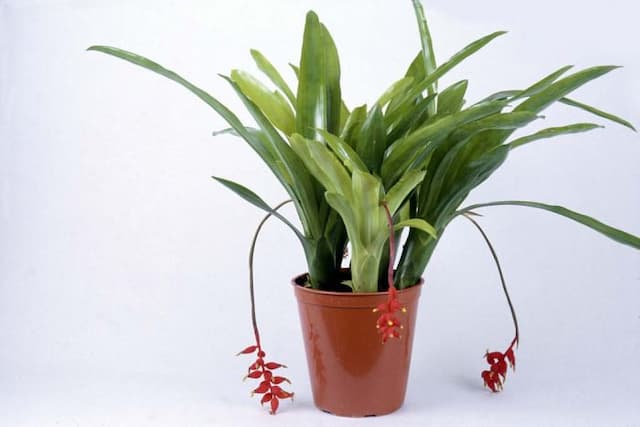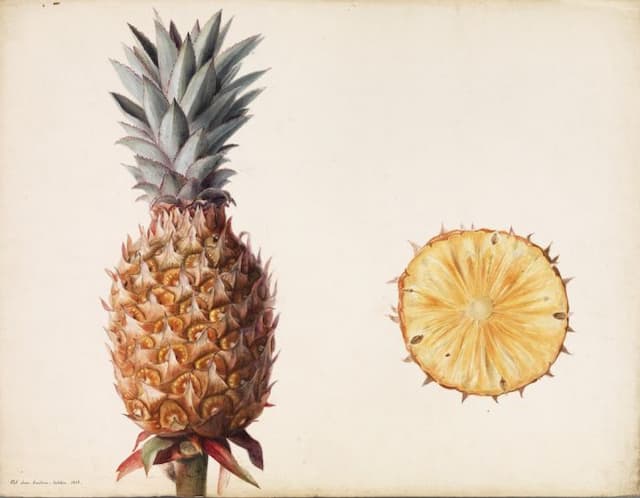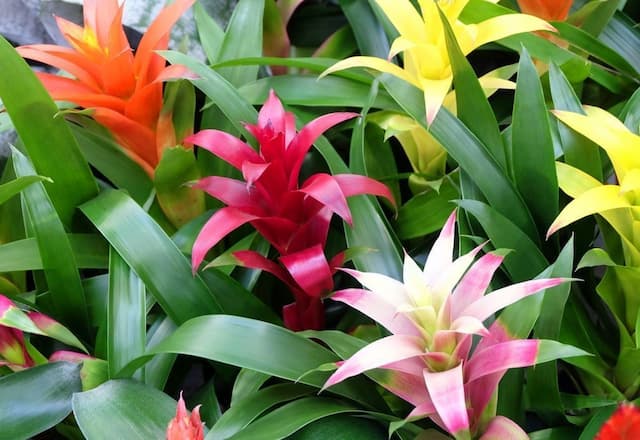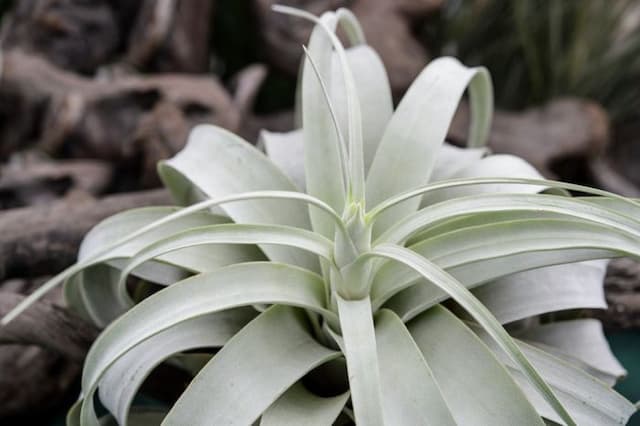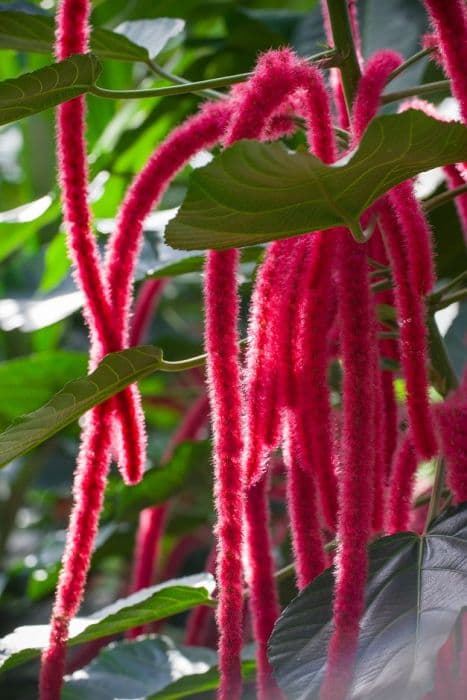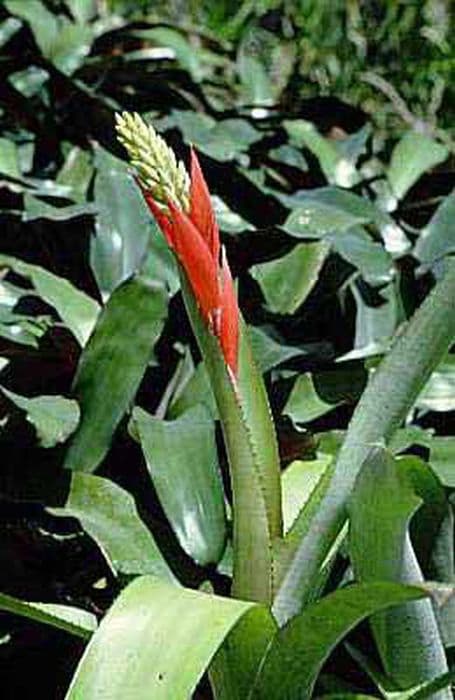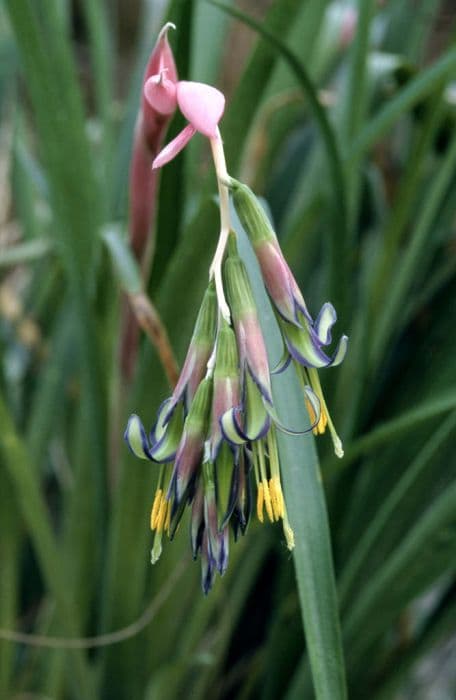Amazonian Zebra Plant Aechmea chantinii

ABOUT
The Aechmea chantinii, commonly known as the Amazonian zebra plant, presents a striking appearance. It is characterized by its rosette of arching leaves, which are long and strap-like. The foliage has a unique coloration and pattern, typically displaying a rich, dark green hue with horizontal bands of silver or white, resembling the stripes of a zebra. The leaves are glossy, with a leathery texture, and have finely toothed edges, which can be sharp to the touch. The Amazonian zebra plant produces an inflorescence that is quite conspicuous and adds to its ornamental appeal. This flowering spike consists of brightly colored bracts, often in shades of pink or red, from which small, tubular flowers emerge. These flowers can vary in color, sometimes seen in blue or purple tones, and are typically quite attractive to hummingbirds and other pollinators. The contrast between the vibrant bracts and the darker, banded foliage creates a dramatic and tropical look, making the plant a popular choice for indoor plant enthusiasts and landscapers alike. The overall impression of the Amazonian zebra plant is that of an exotic and lush specimen, bringing a touch of the Amazon rainforest into the setting in which it's placed.
About this plant
 Names
NamesFamily
Bromeliaceae
Synonyms
Amazonian Zebra Plant, Zebra Plant, Chantin's Bromeliad, Chantinii
Common names
Aechmea chantinii var. chantinii, Aechmea chardinii, Hoplophytum chantinii, Aechmea rubrolilacina, Lamprococcus chantinii.
 Toxicity
ToxicityTo humans
The Amazonian Zebra Plant (Aechmea chantinii) is not considered toxic to humans. There are no well-documented cases of poisoning from ingesting parts of this bromeliad, and it is generally considered safe to handle. However, it's always advisable to avoid ingesting plants that are not confirmed to be edible as a precaution.
To pets
In pets, the Amazonian Zebra Plant is also not recognized as being toxic. This plant isn't known to cause any significant symptoms of poisoning in animals such as dogs or cats if they ingest it. As with humans, consuming plant material not typically part of an animal's diet can sometimes lead to gastrointestinal upset, so it's still best to keep an eye on pets and prevent them from chewing on houseplants.
 Characteristics
CharacteristicsLife cycle
Perennials
Foliage type
Evergreen
Color of leaves
Variegated
Flower color
Mixed
Height
1-2 feet (30-60 cm)
Spread
1-2 feet (30-60 cm)
Plant type
Bromeliad
Hardiness zones
11
Native area
Amazon
Benefits
 General Benefits
General Benefits- Decorative Appeal: Aechmea chantinii, also known as the Amazonian zebra plant, offers striking foliage and a dramatic flower spike, making it a popular ornamental plant for home and office decor.
- Low Maintenance: This bromeliad is relatively easy to care for, requiring minimal watering and feeding, which makes it suitable for busy individuals or those new to plant care.
- Drought Tolerance: It is adapted to withstand periods of dryness, making it a good choice for regions where water conservation is important.
- Long Bloom Period: The Amazonian zebra plant has a long-lasting bloom, providing aesthetic interest for several months.
- Improves Humidity: Aechmea chantinii helps maintain a healthier indoor humidity level, which can be beneficial for human comfort.
- Inspiration for Design: Its exotic look can provide inspiration for both interior and garden designers, offering a tropical aesthetic.
- Habitat for Wildlife: When grown outdoors in suitable climates, it can provide food and shelter for certain species of birds and insects.
- Adaptability: It can grow in a variety of light conditions, which makes it versatile for placing in different environments.
 Medical Properties
Medical PropertiesThis plant is not used for medical purposes.
 Air-purifying Qualities
Air-purifying QualitiesThis plant is not specifically known for air purifying qualities.
 Other Uses
Other Uses- Aechmea chantinii, commonly known as the Amazonian zebra plant, can be used in mixed plant arrangements for a vibrant and textured aesthetic, its striking foliage contributing color and contrast.
- The stiff structure of the leaves allows the Amazonian zebra plant to be used as a natural container or holder for small items when the leaves are woven or pinned together.
- In some cultural artisan crafts, the durable leaves of the Amazonian zebra plant are incorporated into creating decorative items, like woven baskets or mats.
- These plants can be used as living decorations in reptile or amphibian terrariums, providing natural shelter and humidity for the inhabitants.
- The strong, colorful leaves of the Amazonian zebra plant make it a popular choice for adding a tropical flair to floral arrangements and bouquets.
- Photographers sometimes use these plants as a natural backdrop for close-up photography of insects or other small creatures due to the plant's striking patterns.
- Amazonian zebra plants are sometimes used in educational settings to teach about bromeliad epiphytism and rainforest ecology.
- During certain local festivals or ceremonies, parts of the plant may be utilized as natural decorations or symbols of festivity.
- These plants can be incorporated into fashion design elements, especially in the creation of botanical-themed accessories or print designs.
- Due to its upright growth and low water requirements, the Amazonian zebra plant is used in xeriscaping and sustainable landscaping designs to reduce irrigation needs.
Interesting Facts
 Feng Shui
Feng ShuiThe Amazonian zebra plant is not used in Feng Shui practice.
 Zodiac Sign Compitability
Zodiac Sign CompitabilityThe Amazonian zebra plant is not used in astrology practice.
 Plant Symbolism
Plant Symbolism- Exotic Beauty: The Aechmea chantinii, commonly known as the Amazonian Zebra Plant, is often associated with exotic beauty due to its striking appearance, which includes spotted silver bands on its dark green leaves and a vibrant flower spike.
- Resilience: This plant is a bromeliad, which typically symbolizes resilience as they are known for their ability to thrive in a wide range of environmental conditions, often with minimal care.
- Unique Charm: The Amazonian Zebra Plant's unique looks with its zebra-striped leaves can represent the idea of embracing individuality and the beauty of standing out.
- Protection: In some cultures, bromeliads are believed to offer protection to a household, which stems from their hardy nature and the presence of their water-holding rosettes that are said to provide a reservoir of positivity and defense against negativity.
- Longevity: Aechmea chantinii often symbolizes longevity because it has a long-lasting bloom and can live for many years with proper care, reflecting an enduring presence and lasting relationships.
 Water
WaterThe Amazonian zebra plant should be watered thoroughly, allowing the top inch of soil to dry out between waterings. Typically, this plant requires roughly 8-16 ounces of water every week, depending on the humidity and temperature of its environment. It's important to pour water directly into the central cup of the plant and also into the soil to ensure adequate moisture. Over-watering, which can lead to root rot, should be avoided.
 Light
LightThe Amazonian zebra plant thrives best in bright, indirect light, with some partial shade. Avoid placing it in direct sunlight, which can scorch its leaves. A spot near an east or west-facing window that receives filtered sunlight is ideal for this bromeliad.
 Temperature
TemperatureThe Amazonian zebra plant prefers warm temperatures, ideally between 60 and 80 degrees Fahrenheit. It can endure a minimum temperature of around 55 degrees Fahrenheit but should never be exposed to temperatures below this, as they can harm the plant. Avoid placing it in areas where it might be subjected to cold drafts.
 Pruning
PruningThe Amazonian zebra plant requires minimal pruning, primarily to remove dead or damaged leaves and spent flower spikes. This can be done at any time of year as needed, but it's best done after the plant finishes blooming. Carefully cut away the undesired parts without damaging the healthy, living tissues.
 Cleaning
CleaningAs needed
 Soil
SoilThe Amazonian Zebra Plant prefers a well-draining, airy potting mix consisting of equal parts orchid bark, perlite, and peat moss, with a pH of 5.5 to 6.0, to mimic its natural epiphytic environment.
 Repotting
RepottingThe Amazonian Zebra Plant should be repotted every 2-3 years, preferably during spring or early summer when the plant is not in bloom.
 Humidity & Misting
Humidity & MistingAmazonian Zebra Plant thrives in high humidity conditions, ideally between 60% and 80%, which is similar to its native tropical habitat.
 Suitable locations
Suitable locationsIndoor
Place in bright, indirect light with high humidity.
Outdoor
Grow in dappled shade, protect from cold, ensure high humidity.
Hardiness zone
10-12 USDA
 Life cycle
Life cycleAechmea chantinii, commonly known as the Amazonian zebra plant, begins its life cycle when a seed germinates in suitable warm and humid conditions, often in the canopy of rainforests or on decaying wood where it can receive dappled sunlight. The seedling develops into a rosette of striped, spiny-edged leaves that can collect and store water and nutrients. As an epiphytic bromeliad, it clings to trees or other supports rather than growing in soil. After a few years, when mature, it produces a flower spike with bracts that are often colorful but the flowers are short-lived. Once the flowering is complete, the Amazonian zebra plant will produce offsets or "pups" around its base, which will grow independently. The original plant gradually dies after flowering and seed production, leaving the pups to continue the cycle.
 Propogation
PropogationPropogation time
Spring-Early Summer
The Aechmea chantinii, commonly known as the Amazonian zebra plant, is typically propagated through the division of offsets, also known as pups. These pups are small plants that develop around the base of the mother plant and have their own root system. The best time to propagate is late spring or early summer when the plant is actively growing. Once a pup is about one-third of the size of the parent and has several roots that are at least 2 to 3 inches (about 5 - 7.5 cm) long, it can be gently removed by hand or with a clean, sharp knife. The base of the pup should be let to dry for a day before it is planted in a well-draining potting mix. It should then be watered sparingly until new growth indicates that it has established itself.
